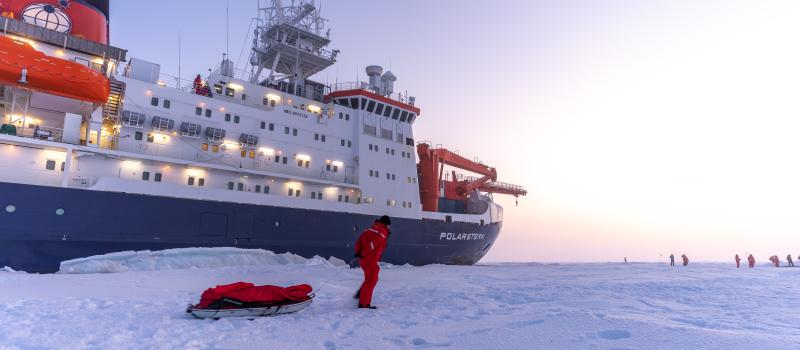
Photo: Janek Uin
The Associated Press is reporting that the RV Polarstern, a German icebreaker carrying scientists on a year-long international expedition in the high Arctic, has reached the North Pole after making an unplanned detour there due to lighter-than-usual sea ice conditions.
Expedition leader Markus Rex said Wednesday the icebreaker was able to reach the geographic North Pole because of large openings in sea ice above Greenland, where shipping would normally be too difficult.
“We made fast progress in a few days,” Rex told The Associated Press. “It’s breathtaking — at times we had open water as far as the eye could see.”
The region above northern Greenland is usually covered in thick sea ice, sometimes built up over several years, that makes it difficult even for ships with ice-strengthened hulls to break through. But the Polarstern was able to make it from the ice edge in the Fram Strait to the pole in less than a week, Rex said.
The scientists on the Polarstern are part of the Multidisciplinary drifting Observatory for the Study of Arctic Climate (MOSAiC) expedition, a one-year-long expedition into the Central Arctic. For the first time a modern research icebreaker is operating in the direct vicinity of the North Pole year-round, including the nearly half year-long polar night during winter. In terms of the logistical challenges involved, the total number of participants, the number of participating countries, and the available budget, MOSAiC represents the largest Arctic expedition in history.
The coronavirus pandemic almost caused the mission to be cut short, as travel restrictions made resupply and crew rotations difficult. But expedition organizers at Germany’s Alfred Wegener Institute for Polar and Ocean Research found a way around the logistical hurdles that involved just a brief break from the ice.
After passing the pole, the Polarstern will anchor to a newly formed floe and observe the start of the freezing process that will see the Arctic covered once more in a mantle of sea ice.
The 100 crew and scientists plan to return to Bremerhaven, Germany, on Oct. 12.
Thanks to Irwin Bryan and Miro Antic for contributing to this post.

Alas a sign of climate change. Where before no ship could navigate.
August 10, 2020
Hundred years old tall ship “Sedov” embarks on historic Arctic voyage
The ship will be the first of its kind that sails across the Northern Sea Route
https://thebarentsobserver.com/en/arctic/2020/08/hundred-years-old-tall-ship-sedov-embarks-historic-arctic-voyage
To show how much the Arctic has changed, in 1997 the Canadian icebreaker Des Groseilliers found suitable ice during project SHEBA to tie into at a much lower latitude than the Polar Stern. The furthest north we got was ~81 degrees. There was much more multi-year ice back then. I was on the Des Groseilliers for 17 weeks during the 1997-1998 experiment and stayed with the ship through the return to Quebec via the Northwest Passage at the end of the experiment. Needless to say it was a trip of a lifetime.
Icebreakers have been to the North Pole before. In the 90’s, the USCG Polar Star and Canadian Coast Guard Louis St Laurent got there together. The Russian icebreaker Yamal showed up shortly after and help an ailing Polar Sea get through the ice on the return. These were all heavy icebreakers and the Polar Stern is not. This is documented in the film By Icebreaker to the North Pole that is available on Amazon.
The most amazing ship attempt at the North Pole was the Fram with Fridtjoft Nansen in 1893-1896. They got above 84 degrees north and realized the Fram wouldn’t make the North Pole. He and Hjalmar Johansen took off with dogs and sleds and attempted to reach the North Pole but came up short at 86.3 degrees north before ice conditions forced a retreat. This amazing expedition is documented in Nansen’s Farthest North and is an excellent read.
To see the shape of Arctic ice, checkout http://nsidc.org/arcticseaicenews/
I’ll stick with Ice Station Zebra with Hudson & Borgnine.
I’m too old to be going to either ends of the Earth.
After the short as.
https://m.imdb.com/video/vi480773401?ref_=m_tt_vi_1